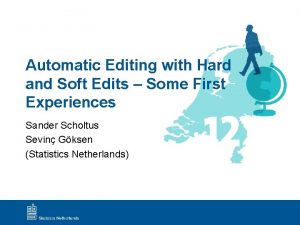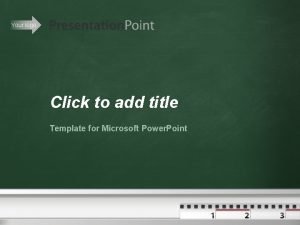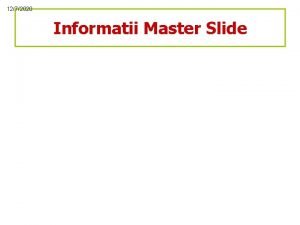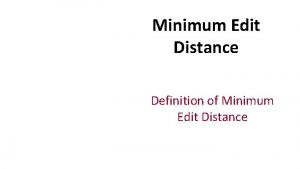TITLE TEXT Click to edit Master text styles




































- Slides: 36

TITLE TEXT › Click to edit Master text styles › Second level › Third level › Fourth level › Fifth level Energy Manager: Optimized Account Setup in Action Speaker: Mike Meola Engagement Manager – Energy Team

Questions After Class? Learning Lab in Ballroom A Presentation will be available for download

Today’s Goal: By the end of this class participants will be able to understand the setup, and building blocks, of their Energy Manager database. Objective 1 Objective 2 Objective 3 Objective 4 Logging In and Navigation Navigating Menu of Setup Parameters Setting Up Your Database Structure Managing Line Items & Entering Utility Bills

Logging in to Energy Manager Login. facilitydude. com energy. dudesolutions. com/energymanager Login. schooldude. com

Navigation and Setup Parameters in Energy Manager

Navigating through Energy Manager features an “accordion” like menu. › You are able to navigate further down to the relevant page you need: ›

This is the Dashboard of your Energy Manager database. In the top left, you have some general stats about your database. In the bottom left, you have your Quick Links menu to help you navigate quicker in Energy Manager. The report shows you a quick snapshot of your Monthly Total Usage and Cost for Energy, Water, or All Utilities combined. You also have the ability to apply filters, located directly beneath the report.

Adding & Managing Quick Links › › Any page, or even report, in Energy Manager can be added to your Quick Links menu Simply click the pin icon you see within the “accordion” menu to add it to your list of Quick Links

Adding & Managing Quick Links To edit your Quick Links, click on the “Edit List” button on your Quick Links menu You are then able to remove any links by clicking the red X You can also re-order the links, by clicking and dragging the up and down arrows to the far right

Setup Parameters › Organization Setup has some key areas to help you set up some key parameters on how your database can function the way you’d like › General Info – Settings & Reports: overall account settings › Utility Services: activating services you’d like to track in Energy Manager › Facility Groups: grouping your facilities for reporting purposes

Setup Parameters: General Info – Settings & Reports › Settings – Allows you to make global, account level changes to your Energy Manager database › Reports – Change your YTD period (fiscal or calendar) and also reporting units (k. Wh, therms, ccf, etc)

Setup Parameters: Utility Services allows you to turn on, or off, any services you’d like to track, or not track, in Energy Manager You also have the ability to create and track 2 custom utility services

Setup Parameters: Facility Groups allows you to group your facilities to help you report on certain facility types Ex: types of schools, admin buildings, court houses, etc

Setting Up Facility Groups Click on + Add Group Enter the name of the category of buildings you are grouping Once you save, you’ll be able to add your “Subgroup”, or the different facility types Start by entering the subgroup name. Then click on “Select Facilities” to add the facilities to the subgroup

Setting Up Facility Groups Find the appropriate facilities in the list, select them, and then click the arrow ( > ) to add them to the box on the right. Once you click OK, the facilities will be added to the subgroup you created

Facility Groups After adding your facilities, you’ll be able to see how many facilities fall within each group This is helpful later on in reporting because you are able to report on specific facility types. If you select a particular subgroup, any facilities included in that subgroup will be referenced in the report You can even report on the top level group, including ALL subgroups and ALL facilities within those subgroups

Setting Up Your Database Structure in Energy Manager

Setting Up Your Database Structure This is where you can go to add a new Facility by clicking on + Add Facility You can also edit any of your existing Facilities by clicking on the name of the Facility to bring up its info General Info, found under Facility Details, is where you can go to see and manage your existing facilities in Energy Manager This is also where you can go to add a new Facility

Setting Up Your Database Structure Any field with two red asterisks ** indicates a required field that must be filled out before saving Some Helpful Tips: On the “Addresses” tab, put in the address and zip code of your Facility. Energy Manager will then automatically assign the nearest weather station to that zip code, if found in the available list If a Facility closes, don’t delete it from Energy Manager. Simply check the “Closed? ” box and enter in a date the facility closed. Energy Manager will mark the Facility as closed so you can retain any historical data associated to that facility Current floor area (Sq. Ft) is not required, but is essential in getting the most out of reporting. Having your square footage will allow you to get cost and use per square foot in reports

Setting Up Your Database Structure Vendors, found under Utility Accounts, is where you can go to see and manage your existing vendors in Energy Manager You can add a new Vendor by clicking on the + Add Vendor button

Setting Up Your Database Structure Enter in the name of your Vendor (utility provider) and then check each Services box to indicate which services that vendor provides to your organization The “Addresses” tab allows you to save the physical and billing addresses for the vendor The “Contacts” tab allows you to save any contact information for the vendor

Setting Up Your Database Structure Accounts & Meters found under Utility Accounts is where you can go to see and manage your existing Accounts, and also Meters, in Energy Manager You can add a new Account by clicking on the + Add Account button

Setting Up Your Database Structure When entering a new account, you will select: 1. The facility it’s associated with 2. The vendor the account is with Then you will add the account number and the start date of when the account was opened. (If you don’t know the exact date, but know the year, putting 1/1/YYYY is sufficient) Helpful Tip: If an account closes, don’t delete it. Put in an “End Date” and Energy Manager will mark the account as closed so you can retain the historical data

Setting Up Your Database Structure After adding an Account and clicking “Save”, the “Meters” tab will become available for you to add a meter to the account You can add multiple meters, for different services, to one account by clicking the + Add Meter button You can also manage existing meters by clicking on the Meter Name in the list

Setting Up Your Database Structure Enter in the name of your meter and select the service the meter is associated with Also be sure to select the appropriate Meter Unit of measure you’d like to track for the service (Ex: k. Wh, Gallons, Therms, CCF, etc) Helpful Tips: If you don’t have a meter name, or meter number, on your utility bill then you can simply list the service (Water, Electric, etc); OR, list the account number as your Meter Name If a meter is removed, don’t delete it out of Energy Manager. Uncheck the “Is active? ” box and enter in a Date Inactive. Energy Manager will mark the meter as closed and you can keep the historical data associated to the meter

Managing Line Items and Entering Utility Bills

Managing Line Items › › Line Item Types in Energy Manager allows you to break out each line item shown on your utility bill You have the ability to add line items types for any special charges that may appear Click + Add Type to add a new Line Item “Line Item Types” is found under the Billing Data section in Energy Manager

Managing Line Items 1. Put in the name of the line item as it appears on your bill 2. Select the service it applies to 3. Choose the Billing Category 4. And choose the Subtype when necessary Billing Category Types: • Usage (and associated Cost) - This is for any usage amounts you’ll be entering into Energy Manager that have an associated cost (electric usage, gas usage, water usage, etc) • Charges – Use this for any credits, charges, late fees, etc • Taxes – This would be used for any tax related charges • Other (Measured) – Used for any charges on your bill with usage listed, but the usage is for informational only and not tracked against your facility

Entering Utility Bills Energy Manager will automatically ask you to select an account you’d like to add a bill for “Utility Bills” under the Billing Data section is where you will go to enter in your utility bills Rather than scrolling through the list, you can begin typing the account number in the search bar and Energy Manager will actively search for account numbers that include the characters you are typing You can also use the Facility and Vendor filters to find a specific account

Entering Utility Bills • Bill Date is where you will enter in the date of your utility bill • Bill amount is where you will enter in the “Total Amount Due” that shows on your utility bill • Balance will show the Bill Amount in Red, with the Current total displaying $0. 00 • Once you begin to enter in your line item charges, Energy Manager will actively log how much you’ve accounted for and how much is left to be accounted for in your line items. Ensuring you capture your entire bill amount

Entering Utility Bills • The Line Item Type column is where you can select your line items to build out your utility bill • You can add as many line items as you’d like, essentially being able to replicate your utility bill in Energy Manager • Once you save your bill, Energy Manager will save this bill template keeping the same line items and Meter(s) selected for quicker data entry on the next month’s bill • Energy Manager also allows for multiple services to be tracked on the same bill • If 1 account has multiple services, just add a meter for each service. Then you are able to enter 1 bill for multiple services

Entering Utility Bills • The line item Start Date and End Date fields are for you to enter in the start and end date of the billing cycle • If your bill doesn’t have Start and End dates, it could be listed as the “previous read” and “current read” dates • The usage and cost columns are for you to enter in the usage and cost amounts for the line items on your bill • Any line items that are just cost (charges) will be entered in the Cost column, with usage grayed out

Entering Utility Bills Pro Tip! • If you have a line item on your bill, and it’s no longer on any future bills…simply click the red X to delete a line item • Once saved, Energy Manager will save that template and the line item won’t be on your bills going forward • New line item appears? Simply add it, save the bill, and Energy Manager will save that new template going forward Double Pro Tip! • If you would like to re-order the sequence of your line items, just click the up and down arrows and drag them to the position you’d like


Still Have Questions? Head to the Learning Lab! Learning Lab in Ballroom A Presentation will be available for download

TITLE TEXT › Click to edit Master text styles › Second level › Third level › Fourth level › Fifth level
 Click to edit master title style
Click to edit master title style Informaatika mitteinformaatikutele
Informaatika mitteinformaatikutele Click to edit master title style
Click to edit master title style Click to edit master title style
Click to edit master title style Soft edit meaning
Soft edit meaning Click clever
Click clever Cyber safety
Cyber safety Click clever click safe
Click clever click safe Click clever click safe
Click clever click safe Master text styles
Master text styles Click to add title
Click to add title Click to add title
Click to add title Click to add title
Click to add title Making connections
Making connections Click here to add text
Click here to add text Click to add text
Click to add text Master title style
Master title style Who taught how
Who taught how Master title style
Master title style Master title
Master title What is a slide-title master pair
What is a slide-title master pair Prefatory elements
Prefatory elements Title title
Title title Kriston edit
Kriston edit Kronos workforce central 8
Kronos workforce central 8 Quick edit+
Quick edit+ Peer editing meaning
Peer editing meaning Minimum edit distance nlp
Minimum edit distance nlp Edit decision list
Edit decision list Feel free to edit
Feel free to edit Everyday edit
Everyday edit Software bioedit
Software bioedit Lc3 simulator
Lc3 simulator Frivaldszky edit
Frivaldszky edit Minimum edit distance backtrace
Minimum edit distance backtrace @qussaiomarii:https://forms.gle/1fbyoualyf1wnwt19
@qussaiomarii:https://forms.gle/1fbyoualyf1wnwt19 Yang merupakan modus edit, kecuali
Yang merupakan modus edit, kecuali




























































